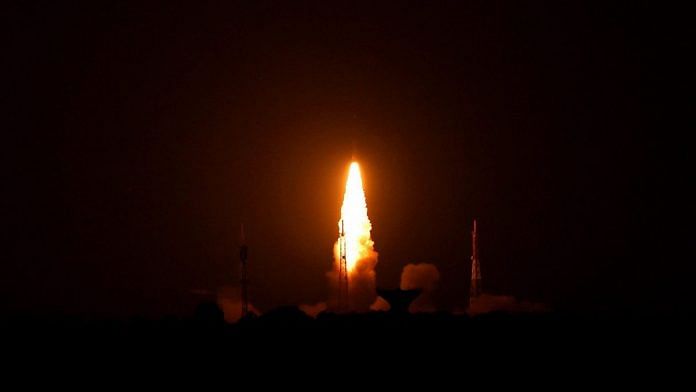ISRO launched the Microsat-R, an imaging satellite for the military, and the experimental Kalamsat for studying communication systems of nano satellites.
Sriharikota (AP): India successfully launched Microsat-R, a military satellite on board its Polar rocket PSLV C44, from the spaceport here on Thursday, in the first mission for the ISRO in 2019.
The Indian Space Research Organisation’s (ISRO) workhorse Polar Satellite Launch Vehicle (PSLV) blasted off from the first launchpad of the Satish Dhawan Space Centre at 11.37 pm at the end of a 28-hour countdown.
In a textbook launch, the 44-metre tall, four-stage PSLV-C44 soared into the clear and starry night sky majestically and injected the 740-kg Microsat-R into orbit precisely 13 minutes and 30 seconds later.
ISRO scientists broke into celebration at the mission control centre here, about 130 km from Chennai, as the Microsat-R was released in a 274-km polar sun synchronous orbit, marking another success story for the space agency.
Former ISRO chairmen Krishnaswamy Kasturirangan and AS Kiran Kumar were among those who witnessed the launch.
The fourth stage of the rocket with co-passenger Kalamsat, a students’ payload, would now be moved to a higher circular orbit, around 450 kms from earth, so as to establish an orbital platform for carrying out experiments.
The ISRO said it would take about 90 minutes for the fourth stage to reach the desired orbit.
Microsat-R, an imaging satellite, is meant for military purposes, but the ISRO did not give any details about it.
Built at a cost of around Rs 12 lakh, the Kalamsat is an experimental satellite for studying the communication system of nano satellites, which can be useful in many fields, predominantly disaster management.
The PSLV C44 is the first launch for the country’s space agency in 2019.
Also read: ISRO sets target for 2019, plans 32 missions including Chandrayaan-2
The PSLV-C44, assembled in 30 days, was the first mission of a new variant of the PSLV, called the PSLV-DL, as it was equipped with two strap-on configurations, the ISRO said.
Usually, PSLVs were launched without any strap-ons (boosters) or were equipped with six strap-ons fixed around the rocket, but the ISRO, for the first time, used only two boosters for the mission, an official of the space agency said.
He added that for the first time, the ISRO placed a satellite — Microsat-R — in a lower orbit, at around 274 kms from earth.
Contributed by college students and the members of a Chennai-based organisation — Space Kidz India — Kalamsat is the first to use PS4 (the fourth stage of the vehicle) as a platform to orbit around the earth.
“We have been working on the project for over six years now. These students are from various backgrounds and the youngest one is studying B.Sc Physics,” Space Kidz India CEO Srimathy Kesan told PTI.
Kesan said Kalamsat was the lightest ever satellite to be launched by India.
Space Kidz India aims to nurture young scientists.
With this, the PSLV, basically a four-stage vehicle with alternating solid and liquid stages, has launched 54 Indian and 269 satellites of international customers.
Speaking after the launch, ISRO Chairman K Sivan said PSLV C44 was not just another PSLV. “There are many firsts and innovations in this mission. First of all, a new variant of PSLV with two strap on is introduced in this mission to enhance payload capability of PSLV beyond core alone configuration.
“Second, the PS4 is made out of aluminium tanks in order to reduce cost of (the) PSLV. Another major change, this is the mission having orbit in the lowest altitude where (the) PSLV has flown so far. Yet another innovation, is making PS4 working after it does its function,” Sivan said.
Saying that ISRO’s highest priority at present is Gaganyaan, Sivan said the human space mission would be done by December 2021. “ISRO has taken a major responsibility for placing a man in space by an Indian vehicle launched from Indian soil. It will happen by December 2021.”
Announcing that the ISRO is working on a new launch vehicle meant for smaller satellites – SSLV (small satellite launch vehicle), Sivan said first launch of the vehicle would happen this year.
Congratulating students for working on Kalamsat, Sivan urged students to bring science experiments to the space agency. “ISRO is an Indian property and open to all students of the country. I request you bring your science experiments, and plug in to PS4. We will launch and you don’t worry. You do science research and make science oriented,” he added.-PTI






